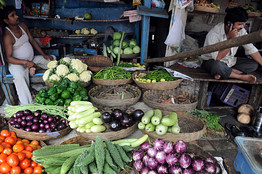Rising Food Prices: Déjà Vu All Over Again

Food inflation, according to the wholesale price index released Thursday, rose 2.5% in the week to Dec. 25 and rose 18.32% from a year ago, up from a rate of 14.44% a week before
The last time the economy was really hot – before the chill winds of the economic crisis swept across the globe – the big worry was that rising inflation, especially in food prices, would scupper the Indian miracle.
Here we are three years later, with robust growth in India and some signs that the global economy is starting to pick up a bit and what do we have: Renewed fears that high inflation, driven by soaring food prices, will undermine India’s economic promise.
As Home Minister P. Chidambaram said Wednesday, in what is being viewed as a dig at the finance minister, Pranab Mukherjee: “Inflation is the biggest tax which the people have to face.”
Have we learned nothing? Rather, if the question is: Has the government taken the necessary steps to ensure that the reasons the economic train tracks were getting hot when growth was good have been addressed? Then answer has to be no.
Food inflation, according to the wholesale price index released today, rose 2.5% in the week to Dec. 25 and rose 18.32% from a year ago, up from a rate of 14.44% a week before. It was the fifth straight week of rising food prices.
There are many factors at play here: The poor monsoon of a year ago that keeps grain prices at elevated levels. A poor onion crop that has driven up the price of that staple. And a greater demand for protein from rising incomes that has increase demand for milk, where the inflation rate is 24.6%, and egg, meat and fish, up 31%.
But pointing solely to seasonal factors or changes in living habits misses a big factor that is responsible: Government policy and executive inaction.
D.K. Joshi, chief economist at ratings agency Crisil, notes that the onion crop, for instance, wasn’t so poor as to justify its extraordinary price rise. Which suggests that traders are hoarding and trying to game the market. They can do so for the simple reason that supply constraints persist across the agricultural chain.
Last year, when food inflation also was high, there were grains rotting in the fields because storage is so bad.
Agricultural productivity remains appallingly low, yet the government is making it difficult to bring in the changes that would dramatically increase it, such as land reform, the expansion of agri-business, or improved market access that cuts down on wastage.
“Eventually, the long-term solution is improved infrastructure,” Mr. Joshi says, adding that the government needs to “reignite agriculture through productivity reforms, the right seeds, the right technology.”
Otherwise, he says, “food inflation is going to be a problem for the next decade.”
The government, ironically, may be compounding the problem with its social welfare policies. The National Rural Employment Guarantee Act, which promises 100 rupees a day for rural workers for 100 days a year, is little more than a dole. It could be a driver of more productive agriculture but there are few signs of that so far.
Yet, Mr. Joshi notes, it pays more than many agricultural jobs, driving up the cost that agriculturalists have to pay their workers. It also puts more money in the hands of workers—men and women—who can then improve their dietary habits a tad. So, too, can those at the bottom of the socio-economic pyramid who have seen some benefit from the nation’s economic growth. That increases demand for food that the supply struggles to meet, so prices rise.
Amit Mitra, chief of the Federation of Indian Chambers of Commerce and Industry, agreed with the assessment that rural demand and spending on food is up.
“Monetary policy has become an ineffective tool for containing food inflation,” said Mr. Mitra in a statement Thursday. “Unless we increase production substantially and address bottlenecks in the supply chain, we will not be able to control inflation.”
By Paul Beckett
January 6, 2011, 5:18 PM IST
Source: The Wall Street Journal